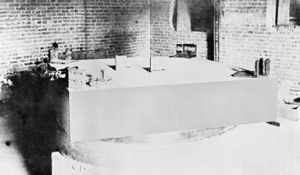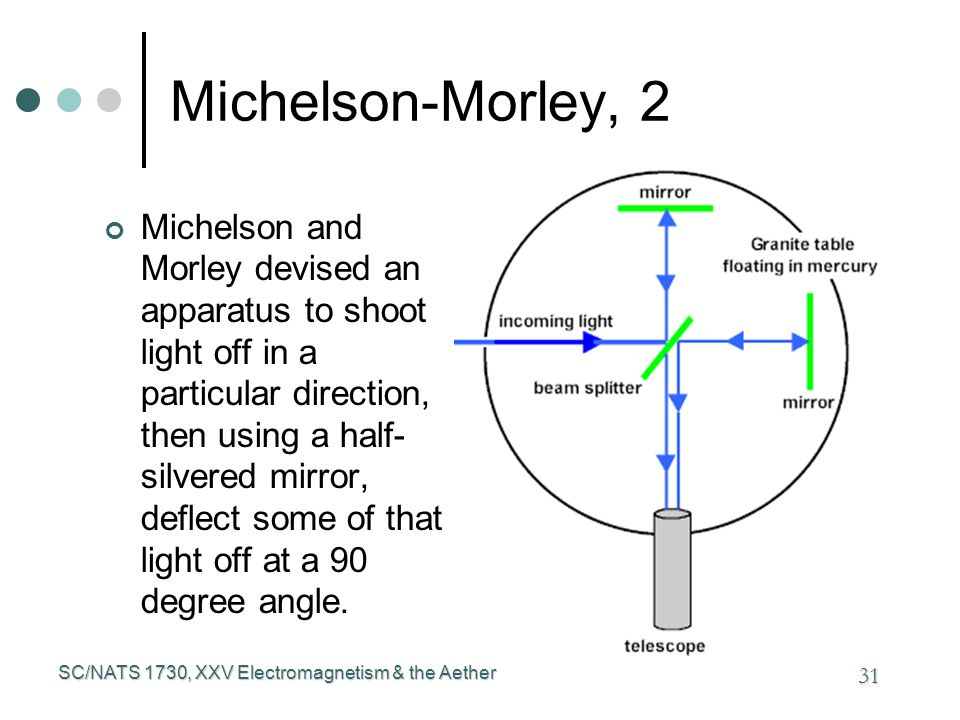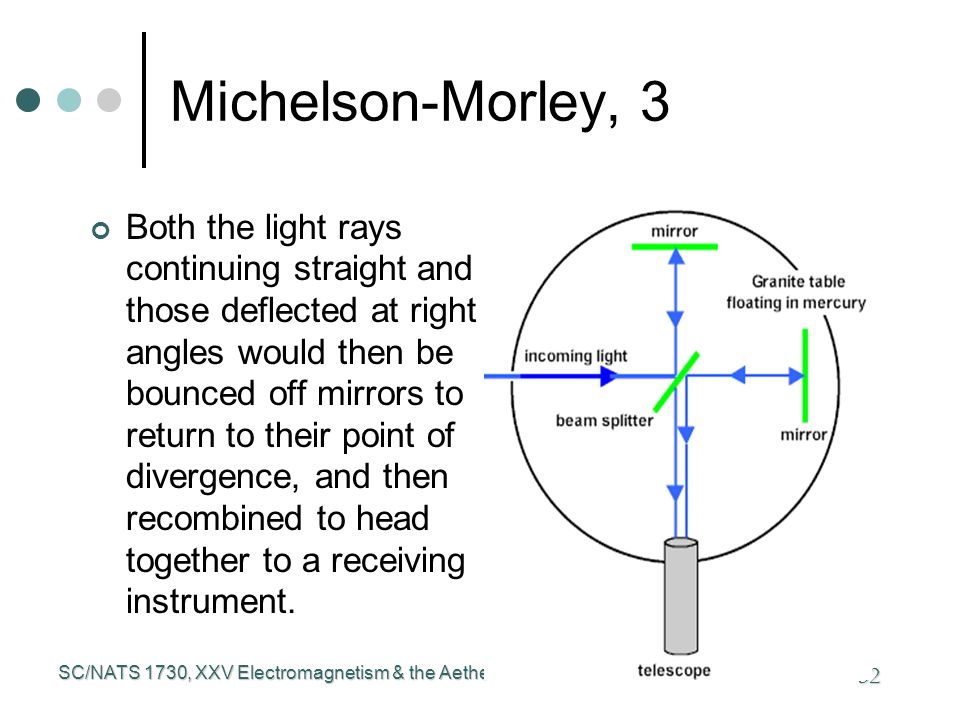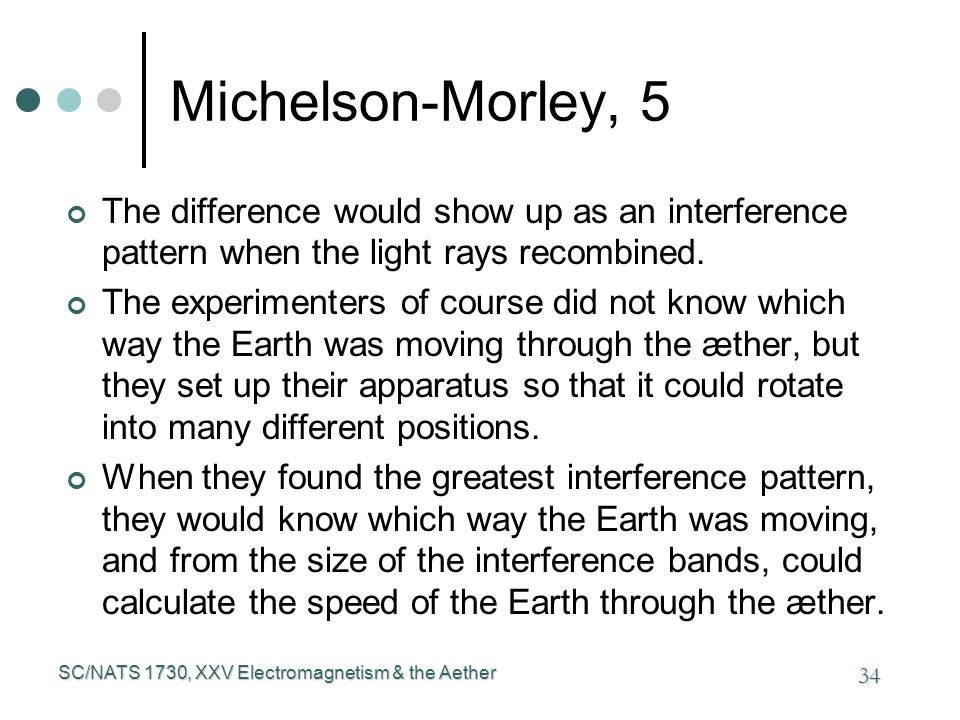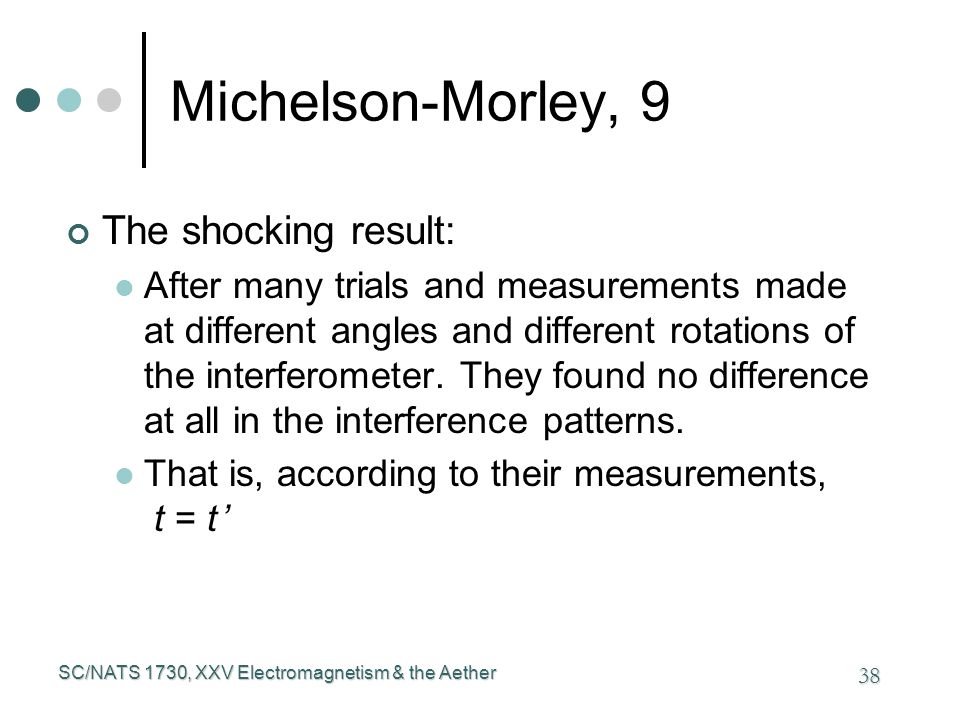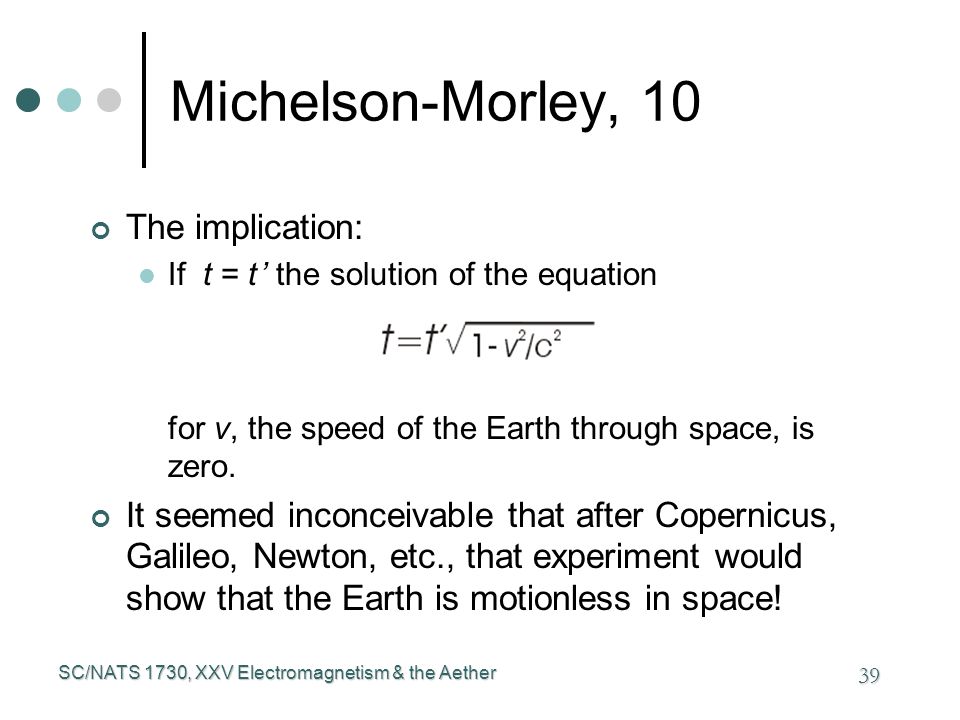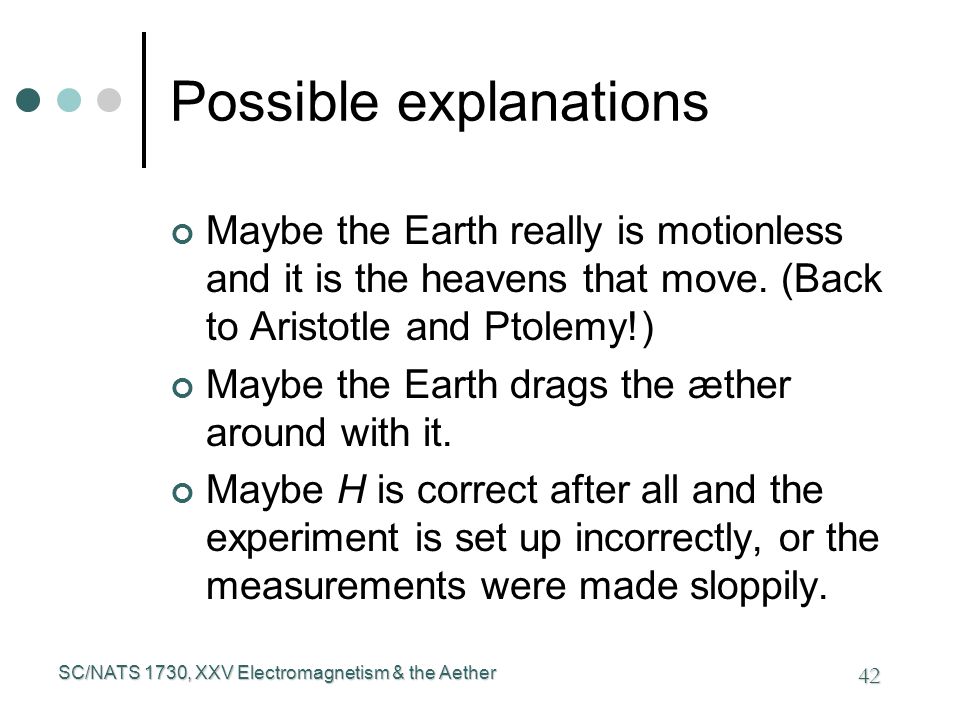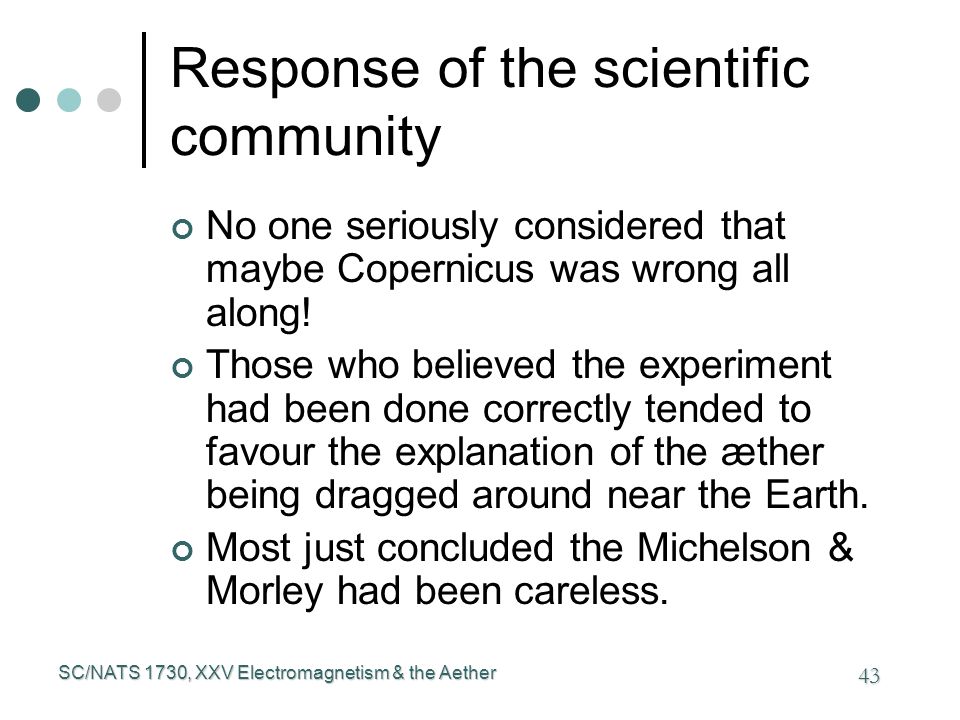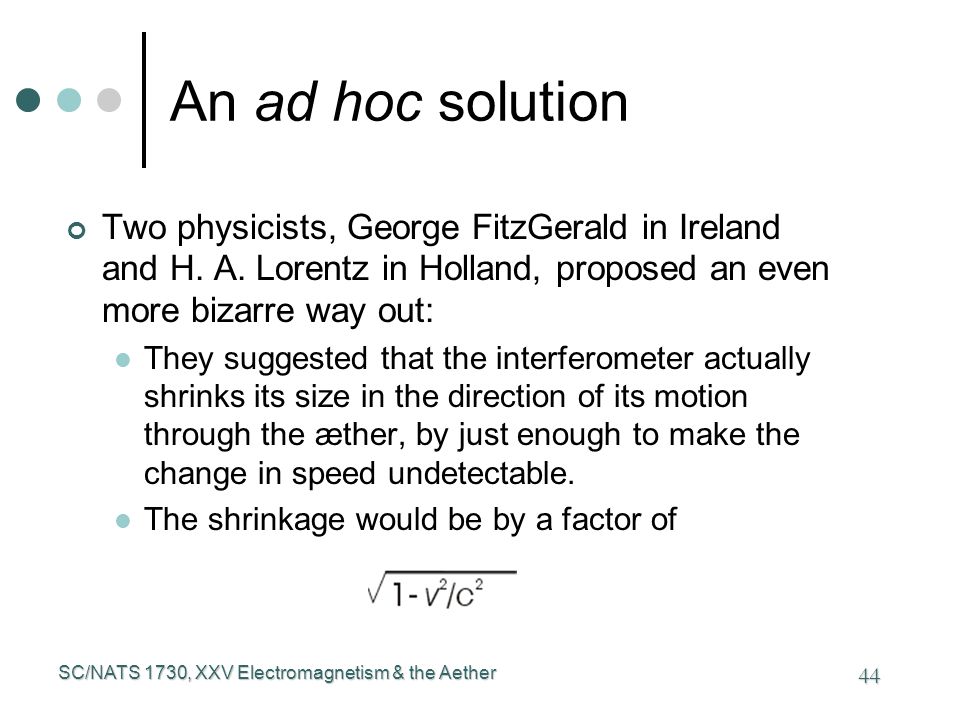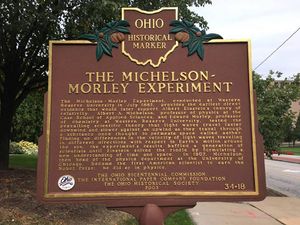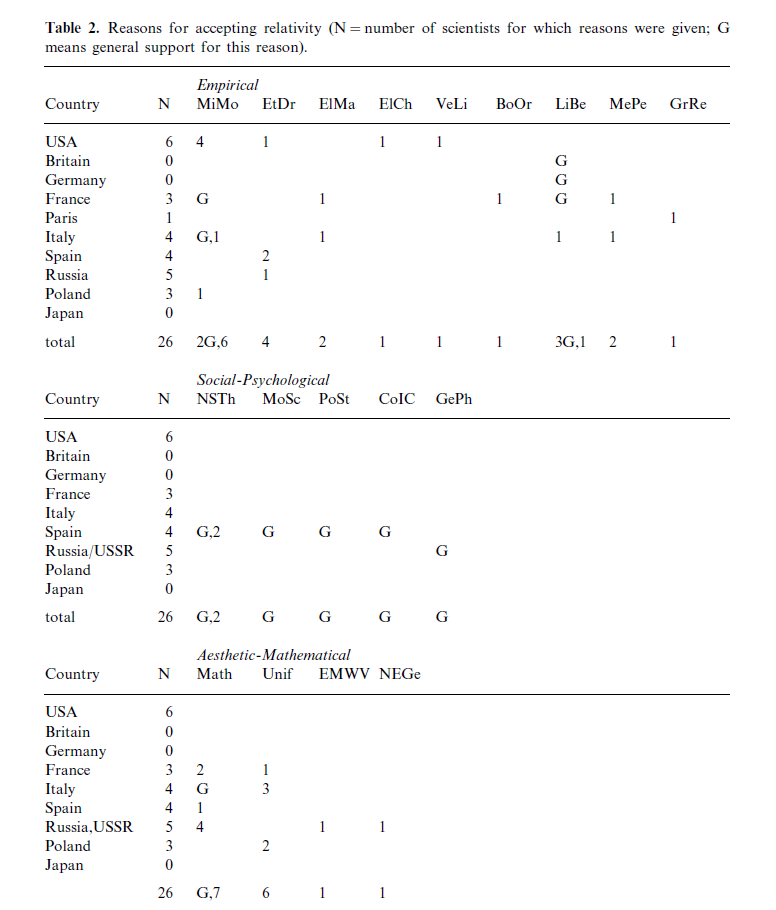Difference between revisions of "Michelson-Morley Experiment"
Tom Bishop (talk | contribs) |
Tom Bishop (talk | contribs) |
||
| Line 1: | Line 1: | ||
[[File:Michelson-Morley-Equipment.jpg|thumb|The Michelson–Morley Experiment]]The '''Michelson–Morley experiment''' was an experiment that was first performed in 1887 by Albert A. Michelson and Edward W. Morley. Unfortunately, a number of writers on this topic tend to gloss over, or sometimes mischaracterize, what this experiment demonstrated, its significance, and how it was a turning point in science which necessitated the adoption of a radically different and alternative model of space. | [[File:Michelson-Morley-Equipment.jpg|thumb|The Michelson–Morley Experiment]]The '''Michelson–Morley experiment''' was an experiment that was first performed in 1887 by Albert A. Michelson and Edward W. Morley. Unfortunately, a number of writers on this topic tend to gloss over, or sometimes mischaracterize, what this experiment demonstrated, its significance, and how it was a turning point in science which necessitated the adoption of a radically different and alternative model of space. | ||
| − | At the time it was held that in order for light waves to travel through a vacuum it was necessary that there was a medium filling the void through which it could propagate, as sound through air or ripples in a pool. The goal of the Michelson–Morley experiment was to compare the speed of light in perpendicular horizontal directions at various times of the day, in an attempt to detect the relative motion of matter through the stationary luminiferous aether by using the rotation of the earth and its motion around the sun to create interference bands of light for the study. Morley wrote to his father that the purpose of the experiment was “to see if light travels with the same velocity in all directions.”<sup>1</sup> | + | At the time it was held that in order for light waves to travel through a vacuum it was necessary that there was a medium filling the void through which it could propagate, as sound through air or ripples in a pool. This background medium was colloquially known as 'aether'. The goal of the Michelson–Morley experiment was to compare the speed of light in perpendicular horizontal directions at various times of the day, in an attempt to detect the relative motion of matter through the stationary luminiferous aether by using the rotation of the earth and its motion around the sun to create interference bands of light for the study. Morley wrote to his father that the purpose of the experiment was “to see if light travels with the same velocity in all directions.”<sup>1</sup> |
The shocking result of this experiment is that the earth did not measurably move around the sun at all, in contradiction to all expectations and the accepted astronomical model. Michelson and Morley found that a light beam discharged horizontally in the direction of the Earth’s assumed motion showed virtually no difference in speed from a light beam discharged north to south or south to north. In other words, the experiment failed to detect the Earth moving in or against space, of whatever space was understood to consist. | The shocking result of this experiment is that the earth did not measurably move around the sun at all, in contradiction to all expectations and the accepted astronomical model. Michelson and Morley found that a light beam discharged horizontally in the direction of the Earth’s assumed motion showed virtually no difference in speed from a light beam discharged north to south or south to north. In other words, the experiment failed to detect the Earth moving in or against space, of whatever space was understood to consist. | ||
Revision as of 23:06, 18 July 2019
The Michelson–Morley experiment was an experiment that was first performed in 1887 by Albert A. Michelson and Edward W. Morley. Unfortunately, a number of writers on this topic tend to gloss over, or sometimes mischaracterize, what this experiment demonstrated, its significance, and how it was a turning point in science which necessitated the adoption of a radically different and alternative model of space.
At the time it was held that in order for light waves to travel through a vacuum it was necessary that there was a medium filling the void through which it could propagate, as sound through air or ripples in a pool. This background medium was colloquially known as 'aether'. The goal of the Michelson–Morley experiment was to compare the speed of light in perpendicular horizontal directions at various times of the day, in an attempt to detect the relative motion of matter through the stationary luminiferous aether by using the rotation of the earth and its motion around the sun to create interference bands of light for the study. Morley wrote to his father that the purpose of the experiment was “to see if light travels with the same velocity in all directions.”1
The shocking result of this experiment is that the earth did not measurably move around the sun at all, in contradiction to all expectations and the accepted astronomical model. Michelson and Morley found that a light beam discharged horizontally in the direction of the Earth’s assumed motion showed virtually no difference in speed from a light beam discharged north to south or south to north. In other words, the experiment failed to detect the Earth moving in or against space, of whatever space was understood to consist.
After the famous Michelson-Morley experiment of 1887, one of Albert Einstein's biographers, Ronald W. Clark, describes what came next:
“ The problem which now faced science was considerable. For there seemed to be only three alternatives. The first was that the Earth was standing still, which meant scuttling the whole Copernican theory and was unthinkable. 2 ”
Michelson and Morley and later scientists repeated the experiment many times, and in many different horizontal axial positions and configurations, at different times of the day, all with a null result. The earth was seen to be motionless. The experiment has been referred to as "the moving-off point for the theoretical aspects of the Second Scientific Revolution"3 and directly influenced the creation of Albert Einstein's Theory of Special Relativity.
The Theory of Special Relativity subsequently found favor among scientific circles because the second postulate of Special Relativity provided an illusion where the velocity of light is constant to all observers, and seemingly explained the motionless earth result of the Michelson-Morley experiment. This fundamental change to the nature of space and time allowed the theory of the earth's motion around the sun to survive direct contradicting experimental evidence and encouraged, perhaps forced, its adoption as the accepted model of space for Copernicanism.
G.J. Whitrow, a British mathematician, cosmologist, and science historian, characterized the Michaelson-Morley experiment from a historical perspective:
“ if such an experiment could have been performed in the sixteenth or seventeenth [centuries] when men were debating the rival merits of the Copernican and Ptolemaic systems. The result would surely have been interpreted as conclusive evidence for the immobility of the Earth, and therefore as a triumphant vindication of the Ptolemaic system and irrefutable falsification of the Copernican hypothesis.4 ”
1 Letter dated April 17, 1887, in the Edward W. Morley Papers, Library of Congress, as cited in Dorothy Michelson Livingston’s Master of Light: A Biography of Albert Michelson, New York, Charles Scribner, 1973, p.126.
2 Einstein: The Life and Times, Avon Book, New York, NY, 1984, p. 109-110.
3 Hoover, Earl R. (1977). Cradle of greatness : national and world achievements of Ohio's Western Reserve
4 G. J. Whitrow, The Structure and Evolution of the Universe, New York, Harper and Brothers Publishers, 1959, p. 79.
http://hyperphysics.phy-astr.gsu.edu/hbase/Relativ/mmhist.html (Archive)
“ Although repeated over the next 40 years with ever greater precision and the same negative result, this 1887 experiment is pointed to as one of the experimental foundations of relativity, and earned Michelson the Nobel Prize in 1907. ”
Description and Result
Material from a York University course by Prof. Byron E. Wall provides a good summary of the Michelson-Morley experiment and its result. Below are slides that tell the story. Interested readers should feel free to go through the entire slide deck.
Course Description (Archive)
Full Slideshow (.ppt Archive)
Peer Reviews and Repetitions
Since 1887 the Michelson-Morley experiment has been repeated and verified on many occasions, with several different methodologies. The Michelson-Morley Wikipedia article (Archive) maintains a list of subsequent experiments.
A 2009 repetition of the experiment is described below:
2009 Repetition in Germany
https://physicsworld.com/a/michelson-morley-experiment-is-best-yet/ (Archive)
Michelson–Morley experiment is best yet
“ Physicists in Germany have performed the most precise Michelson-Morley experiment to date, confirming that the speed of light is the same in all directions. The experiment, which involves rotating two optical cavities, is about 10 times more precise than previous experiments – and a hundred million times more precise than Michelson and Morley’s 1887 measurement. ”
Influence of the MiMo Experiment on Relativity
In a lecture titled How I Created the Theory of Relativity (Archive) Albert Einstein points this experiment out as a basis on developing Special Relativity:
“ I was familiar with the strange results of Michelson’s experiment while I was still a student pondering these problems, and instinctively realized that, if we accepted his result as a fact, it would be wrong to think of the motion of the Earth with respect to the ether. This insight actually provided the first route that led me to what we now call the principle of special relativity. I have since come to believe that, although the Earth revolves around the Sun, its motion cannot be ascertained through experiments using light. ”
Einstein also mentions in regards to SR: "I also started to work on the problem of Fizeau’s experiment and tried to account for it," which is another light velocity experiment.
Historical Marker
In Cleveland, Ohio, there is a Michelson-Morley Historical Marker located just outside the science building on the Case Western Reserve University campus which provides the following:
“ The Michelson-Morley Experiment, conducted at the Western Reserve University in July 1887, provides the earliest direct evidence that would later support Albert Einstein's theory of relativity. Albert A. Michelson, professor of physics at the Case School of Applied Sciences, and Edward Morley, professor of chemistry at Western Reserve University, tested the prevailing scientific theory that light waves travel faster downwind and slower against an upwind as they travel faster through a substance once thought to permeate space called aether. Finding no differences in the velocity of light waves traveling in different directions with respect to Earth's motion around the sun, the experiment's results baffled a generation of scientists until Einstein solved the riddle by formulating a new understanding of time and space. In 1907, Michelson, then head of the physics department at the University of Chicago, became the first American scientist to earn the Nobel Prize: he did so in physics. ”
The marker describes that, when science was confronted with direct evidence of an earth without motion around the sun, an entirely new model of space and time was required to explain it.
Why Relativity Was Accepted
Why Was Relativity Accepted?
By Stephen G. Brush
Full Text: http://citeseerx.ist.psu.edu/viewdoc/download?doi=10.1.1.535.1670&rep=rep1&type=pdf (Archive)
An interesting analysis on why Relativity was accepted in science. The author concludes that much of why it was accepted is because it was a world-model which purported to explain the Michelson-Morley experimental result of a motionless earth. Another top reason was because of an underlying desire for a unified, elegant physical theory.
The author provides quotes by the scientists of the day, identifying the Michelson-Morley null result as a primary factor.
Remarks by Prominent Physicists
“ José Sánchez-Ron [a prominent Spanish physicist] suggests that G.A. Schott and other British physicists were interested in relativity because it offered a way to deal with problems arising from the new atomic physics, in which the magnetic interactions of electrons and their behavior at very high speeds needed to be better understood.
Sánchez-Ron also points to the interest of these physicists in symmetry considerations. But the most explicit statement he quotes about the reason for accepting relativity is that of an anonymous reviewer of Ludwik Silberstein’s 1914 book: "without the result of Michelson and Morley’s experiment there would be no justification for the theory at all... [It] will only be when further experimental data of a crucial kind are obtained that the theory will run much chance of becoming definitely accepted as scientific knowledge." ”
“ In 1907, K.K. Baumgart supported the ‘Lorentz-Einstein theory’ because it was compatible with the negative result of the Michelson-Morley experiment ”
“ Dirac [a famous English theoretical physicist] stated that he first learned about relativity theory when it was widely publicized in England after World War I by Eddington. His initial interest in the theory was captured by the experimental evidence – Michelson-Morley experiment, Mercury’s orbit, and light bending. ”
“ Langevin [a famous French physicist] tried to persuade the Collège de France to invite Einstein to lecture in Paris, and finally succeeded in 1922; the result was a flurry of popular interest in relativity. After Einstein’s visit Langevin decided that relativity is supported by experiments such as that of Michelson and Morley. ”
Statistical Tables
The author provides three statistical analysis tables for why Relativity was accepted, focusing on Empirical reasons, Social-Psychological reasons, and Aesthetic-Mathematical reasons.
Abbreviation Reference
Empirical
MiMo — negative result of Michelson-Morley experiment
EtDr — failure of ether drift experiments
ElMa — variation of electron mass with velocity
ElCh — variation of electron charge with velocity
VeLi — velocity of light from terrestrial and celestial sources is the same
BoOr — correction of orbits and energy levels in Bohr model of atom
LiBe — light-bending observations
MePe — Advance of Mercury Perihelion
GrRe — Gravitational redshift of spectral lines
Social-Psychological
NSTh — rejection of absolute space and time is consistent with neo-scholastic theology
MoSc — association with ‘‘modern’’ science
PoSt — relativism of political structures, attractive to anti-democratic ideologues
CoIC — acquire prestige for comprehending the incomprehensible
GePh — respect for authority of German physics
Aesthetic-Mathematical
Math — mathematical aspects of the theory
Unif — desire for a unified, elegant physical theory
EMWV — connection with electromagnetic worldview
NEGe — connection with Lobachevsky’s non-Euclidean geometry
The reader should note that the Michelson-Morley Experiments are a subset of the "failure of the ether drift experiments," which are a larger collection of experiments which have failed to detect earth's motion through space. The Michelson-Morley Experiment is the most known and famous experiment of the collection.
How Einstein Made the Earth Move
Video: How Einstein Made the Earth Move
By Jeran Campanella and Robert Sungenis
Description: "This video is a reading of a PDF written by Robert Sungenis in 2016 called "Albert Einstein: The Earth Mover- How Einstein Made The Earth Move (When All The Experiments Showed It Didn't Move)" This video will challenge you to decide which belief is pseudoscientific... the belief that the Earth moves... or that it stands still."
Quotes
Below are miscellaneous quotes from various physicists and authors on the topic of the Michelson-Morley Experiment.
“ If you haven't given much thought to the implications of twentieth-century science, you may be chagrined...to realize that because of the concept of relative motion, no one can prove that the Earth moves. ”
- —Kitty Ferguson, Measuring the Universe, 1999, p. 106, 107
“ No physical experiment ever proved that the Earth actually is in motion. ”
- —Lincoln Barnett, The Universe and Dr. Einstein, 2nd rev. edition, 1957, p. 73.
“ In the effort to explain the Michelson-Morley experiment...the thought was advanced that the Earth might be stationary. ”
- —Creator of the first IQ test - Arthur S. Otis
“ The experiment was tried again by Morley and by others, with the same conclusion; the apparent velocity of the earth through the ether was zero. ”
- —Historian Lincoln Barnett, The Universe and Dr. Einstein, p. 44.
“ The easiest explanation was that the earth was fixed in the ether and that everything else in the universe moved with respect to the earth and the ether …Such an idea was not considered seriously ”
- —James A. Coleman, Relativity for the Layman, p. 37.
“ It could have detected speeds as low as two miles a second instead of the known 20mps that the earth as in its orbital motion around the sun. It didn’t detect it. What’s the conclusion from the Michelson‐Morley experiment? The implication is that the earth is not moving ”
- —Professor of Physics Richard Wolfson- “The Teaching Company”, episode taught at Middlebury College.
“ This conclusion directly contradicts the explanation... which presupposes that the Earth moves. ”
- —Albert Michelson (Albert A. Michelson, “The Relative Motion of the Earth and the Luminiferous Ether,” American Journal of Science, Vol. 22, August 1881, p. 125)
“ There was just one alternative; the earth's true velocity through space might happen to have been nil. ”
- —Arthur Eddington, The Nature of the Physical World, 1929, pp. 11, 8
“ The data were almost unbelievable… There was only one other possible conclusion to draw — that the Earth was at rest....This, of course, was preposterous ”
- —Bernard Jaffe, Michelson and the Speed of Light, 1960, p. 76
“ ...to the question whether or not the motion of the Earth in space can be made perceptible in terrestrial experiments. We have already remarked... that all attempts of this nature led to a negative result. Before the theory of relativity was put forward, it was difficult to become reconciled to this negative result. ”
- —Relativity — The Special and General Theory, cited in Stephen Hawking's, 'A Stubbornly Persistent Illusion', 2007, p. 169.
“ This ‘null’ result was one of the great puzzles of physics at the end of the nineteenth century. One possibility was that...v would be zero and no fringe shift would be expected. But this implies that the earth is somehow a preferred object; only with respect to the earth would the speed of light be c as predicted by Maxwell’s equations. This is tantamount to assuming that the earth is the central body of the universe. ”
- —Physicist Douglas C. Giancoli, Physics: Principles with Applications, 1985, pp. 613-614 and 1980, p. 625.

